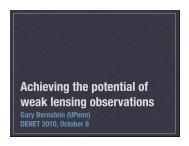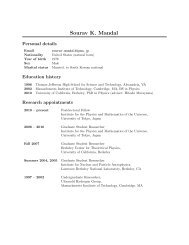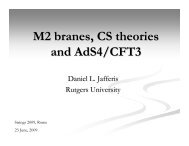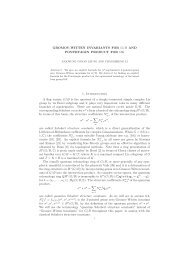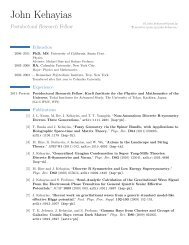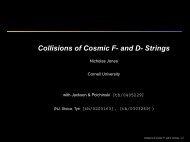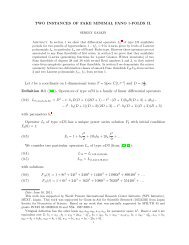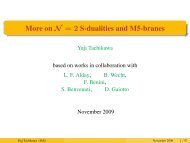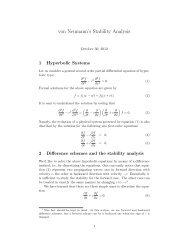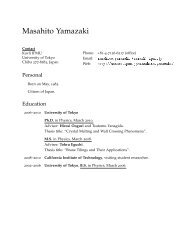STUDY SUMMARY - IPMU
STUDY SUMMARY - IPMU
STUDY SUMMARY - IPMU
Create successful ePaper yourself
Turn your PDF publications into a flip-book with our unique Google optimized e-Paper software.
<strong>SUMMARY</strong> REPORT<br />
WIDE FIELD FIBER-FED OPTICAL<br />
MULTI-OBJECT SPECTROMETER (WFMOS)<br />
capability to perform high-level engineering tests to aid in instrument integration and troubleshooting.<br />
The Data Reduction function receives raw data read from the Detector System and uses it to<br />
produce calibrated spectra ready for scientific analysis. The Data Reduction function provides<br />
the capability to reduce data of varying spectral resolution and saves all spectroscopic and image<br />
files in the required data format. The Data Reduction function will also provide the capability to<br />
quickly assess the quality (completeness, signal-to noise ratio, etc.) of the data collected.<br />
A typical observation proceeds as follows. After initialization, instructions are executed to<br />
configure the telescope and instrument for the desired observation. The details of each observation<br />
are pre-planned using software provided by the System Control to aid the researcher in orchestrating<br />
the survey. Using information derived from a catalog of astronomical objects, the<br />
field configuration, including the positions for each of the 2,400 fibers, is computed prior to the<br />
start of the observation. The spectrograph configuration is determined by which of the four primary<br />
science surveys is being executed. A typical observing night might use more than one spectrograph<br />
configuration in order to optimize survey efficiency as sky brightness or the seeing<br />
changes.<br />
Execution of an observation begins with moving the telescope to the desired field center.<br />
While the telescope is slewing, the Fiber Positioning System executes commands from the System<br />
Control to simultaneously move each of the 2,400 fibers to its required position. The Metrology<br />
System is used to verify each fiber’s position. The positioning process proceeds as follows:<br />
1. The current position of each science fiber is determined relative to a set of fixed fiducial<br />
fibers. These fixed fibers are backlit by a dedicated calibration lamp. The backlit fibers<br />
are imaged by the Metrology System and the centroid of each fiber is calculated. Similarly,<br />
the 2,400 science fibers are backlit by calibration lamps in each spectrograph and<br />
imaged by the Metrology System. The centroids of each science fiber image are computed<br />
in order to determine their relative positions.<br />
2. The System Control computes and issues the necessary commands to the Fiber Positioning<br />
System to move the 2,400 science fibers to the positions required for the observation.<br />
The metrology and the fiber movements are coordinated in 3 groups of 800 fibers. Some<br />
operations proceed in parallel.<br />
3. Steps 1 and 2 are repeated several times to accurately position each fiber.<br />
The positioning process is estimated to take less than 40 s from start of telescope pointing to<br />
completion of fiber positioning. In parallel with this process, the Acquisition and Guide System<br />
refines the pointing of the telescope. The Acquisition and Guide System provides feedback to the<br />
telescope pointing and rotator position during the observation. The hexapod is commanded to the<br />
appropriate position to maintain the WFC alignment in the presence of flexure in the PFU.<br />
Once positioning is complete, the Detector System collects data. The Data Reduction System<br />
produces quick-look information on the completed observation so to that survey progress can be<br />
monitored.<br />
3.3 Major Requirements<br />
The OCDD defines the science requirements for WFMOS. These requirements in turn define<br />
the instrument requirements, as described in the FPRD. The WFMOS FPRD has over 60 requirements<br />
on the entire instrument and several hundred requirements on the subsystems. Not all<br />
22



